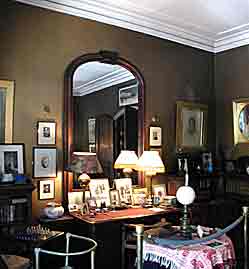Massachusetts
Studies Project
Teaching Tools for Local History:
** MATERIAL CULTURE**
 Introduction:
Material Culture is a fancy way of saying "stuff". Often when
referring to objects used and created by people, students are taught to
call them "artifacts". Historians use the terms "artifacts"
and "material culture" interchangeably. There are as many ways
to use objects in the classroom, as there are objects to use. The most essential
part of using objects in a classroom setting is in invoking their storytelling
power. Objects can tell many tales and are subject to diverse and divergent
interpretations.
Introduction:
Material Culture is a fancy way of saying "stuff". Often when
referring to objects used and created by people, students are taught to
call them "artifacts". Historians use the terms "artifacts"
and "material culture" interchangeably. There are as many ways
to use objects in the classroom, as there are objects to use. The most essential
part of using objects in a classroom setting is in invoking their storytelling
power. Objects can tell many tales and are subject to diverse and divergent
interpretations.
General Teaching Tips: The use of objects as teaching tool is particularly profound when trying to elicit non-linear responses or stories. For example, when doing oral histories with grandparents, students should ask their subjects to tell them about objects that are on the piano or by their bedsides rather than asking a straight list of "Where were you when…" questions. Objects bring up emotional responses and memories easier than linear questions.
Additionally, when teaching in the history classroom, objects have the power to tell tales and link students to the history of other time periods. For example, if students are studying several eras in history, consider linking them together by telling the story of one type of item that across time would be used daily (ex. Shoes, kitchen goods, etc.) Watching how these items changed, including their use and production, provides students with a concrete representation of the abstract changes in society.
All of the information here is designed to help teachers integrate some form of material culture into their classroom, so there is no one set of questions that will effectively cover all the possible angles that a teacher could use with a particular object. Depending on the article you choose, you may need to find questions in other templates that better lead your discussion of the object in question. The essentials for teaching with an object are simply knowing the story you want that object to tell and asking the questions that will help them uncover it. Being comfortable with Socratic questioning is one of the best prerequisites for teaching with material culture.
Basic Questions
- What is it?
- What is it made of?
- What is it used for?
- Who would use it?
- How would they use it? How do you know that?
- What symbols or markings does it contain?
- What does this tell you about the person/people who used it?
- What aspect of society does this relate to: work, home, religion, etc.?
Critical Thinking Questions
- In order for this object to exist, what else needs to exist within the society that created it?
- What does this object say about the people who made it? What do they value?
- What emotions or reactions does this object inspire in you? Would every generation have the same reaction to it? Why or why not?
- What does this object tell you about the social rank, status or class of the individual that used it? What does it say in general about people of that rank, status or class?
- What other objects from this society would you like to see in order to confirm or refute your theories about this object?
Worksheet
Artifact Analysis Worksheet - National Archives and Records Administration
Resources and Websites specifically related to Material Culture
A
Midwife's Tale: The Life of Martha Ballard, Based on Her Diary, 1785-1812
by
Laurel Thatcher Ulrich
Good Wives: Image and Reality in the Lives of Women in Northern New England, 1650-1750 by Laurel Thatcher Ulrich
The Age of Homespun: Objects and Stories in the Creation of an American Myth by Laurel Thatcher Ulrich
Laurel Thatcher Ulrich masterfully uses material culture to tell the stories of the past. Before integrating material culture into the classroom, it is strongly recommended that you read one of her texts.
"DoHistory.org", a companion website to A Midwife’s Tale, offers useful tips about how to analyze and integrate material culture into the classroom.
Model Lesson Materials
"Everyday Life in a New England Town: An Inquiry-based Social Studies Unit for Fifth or Sixth Grade". What do primary and secondary sources teach us about the characteristics of "everyday life" of individuals living in Deerfield at the four turns of the centuries?
What Artifacts Reveal About the Past (Grades 6 - 8)
This
resource book was developed with support from
The Massachusetts Historical Records Advisory Board, Office of the Secretary
of the State
and
The Massachusetts Foundation for the Humanities